Jay, VT Weather Forecast and Current Conditions
Current Conditions From Nearby Station

Feels Like 65°F
at
Current Conditions From Nearby Station

Feels Like 65°F
at
Point Forecast at a Glance







This Date in Weather History
1970 - A nineteen month drought in southern California came to a climax. The drought, which made brush and buildings tinder dry, set up the worst fire conditions in California history as hot Santa Anna winds sent the temperature soaring to 105 degrees at Los Angeles, and to 97 degrees at San Diego. During that last week of September whole communities of interior San Diego County were consumed by fire. Half a million acres were burned, and the fires caused fifty million dollars damage.
More on this and other weather history
Jay 7 Day Weather Forecast Details
Tuesday Sep 30

Day: Sunny, with a high near 64. North wind around 7 mph.

Night: Mostly clear, with a low around 38. North wind 2 to 6 mph.
Wednesday Oct 1

Day: Sunny, with a high near 56. North wind 2 to 7 mph.

Night: Mostly clear, with a low around 35. Northeast wind 1 to 6 mph.
Thursday Oct 2

Day: Patchy frost before 8am. Sunny, with a high near 61. North wind around 1 mph.

Night: Partly cloudy, with a low around 38. Southwest wind around 2 mph.
Friday Oct 3

Day: Sunny, with a high near 67. Southwest wind around 5 mph.

Night: Mostly clear, with a low around 48. Southwest wind around 3 mph.
Saturday Oct 4

Day: Sunny, with a high near 73. Southwest wind around 3 mph.

Night: Partly cloudy, with a low around 54. Southwest wind around 3 mph.
Sunday Oct 5

Day: Sunny, with a high near 78. Southwest wind around 3 mph.

Night: Partly cloudy, with a low around 55. Southwest wind around 3 mph.
Monday Oct 6

Day: Mostly sunny, with a high near 78. Southwest wind around 5 mph.

Night: Partly cloudy, with a low around 56. Southwest wind around 5 mph.
Sun & Moon Monthly
Sunrise 6:47 AM
Sunset 6:33 PM
Last Light 7:03 PM
Moonset 11:55 PM

Contiguous United States Extremes
Mon's High Temperature
101 at 16 Miles Southwest Of Tecopa, CA
Tue's Low Temperature
28 at 9 Miles East-southeast Of Creede, CO and Leadville, CO
Weather Folklore
The low flight of rooks indicates rain.
Current subscribers - login to your ClearSky account
About Jay, Vermont
Jay is one of the northernmost towns in Orleans County, Vermont, United States, located on the Canada–US border. The population was 551 at the 2020 census. Jay is named for John Jay, one of the Founding Fathers of the United States. The US Census Bureau estimated that the town's population had increased by 13.1% between 2000 and 2005, the seventh largest increase in the state. Jay is also home to the Jay Challenge, a three-part stage-race, typically held in July.
Content from Wikipedia, licensed under CC BY-SA 3.0.
How We Provide Better Local Weather
Current conditions: We use the nearest available station to your location - including professional MESONET/MADIS and local weather stations - often miles closer than regional airports.
Forecasts: National Weather Service point forecasts predict for your specific area, not broad regional zones, making them far more relevant to your location.

